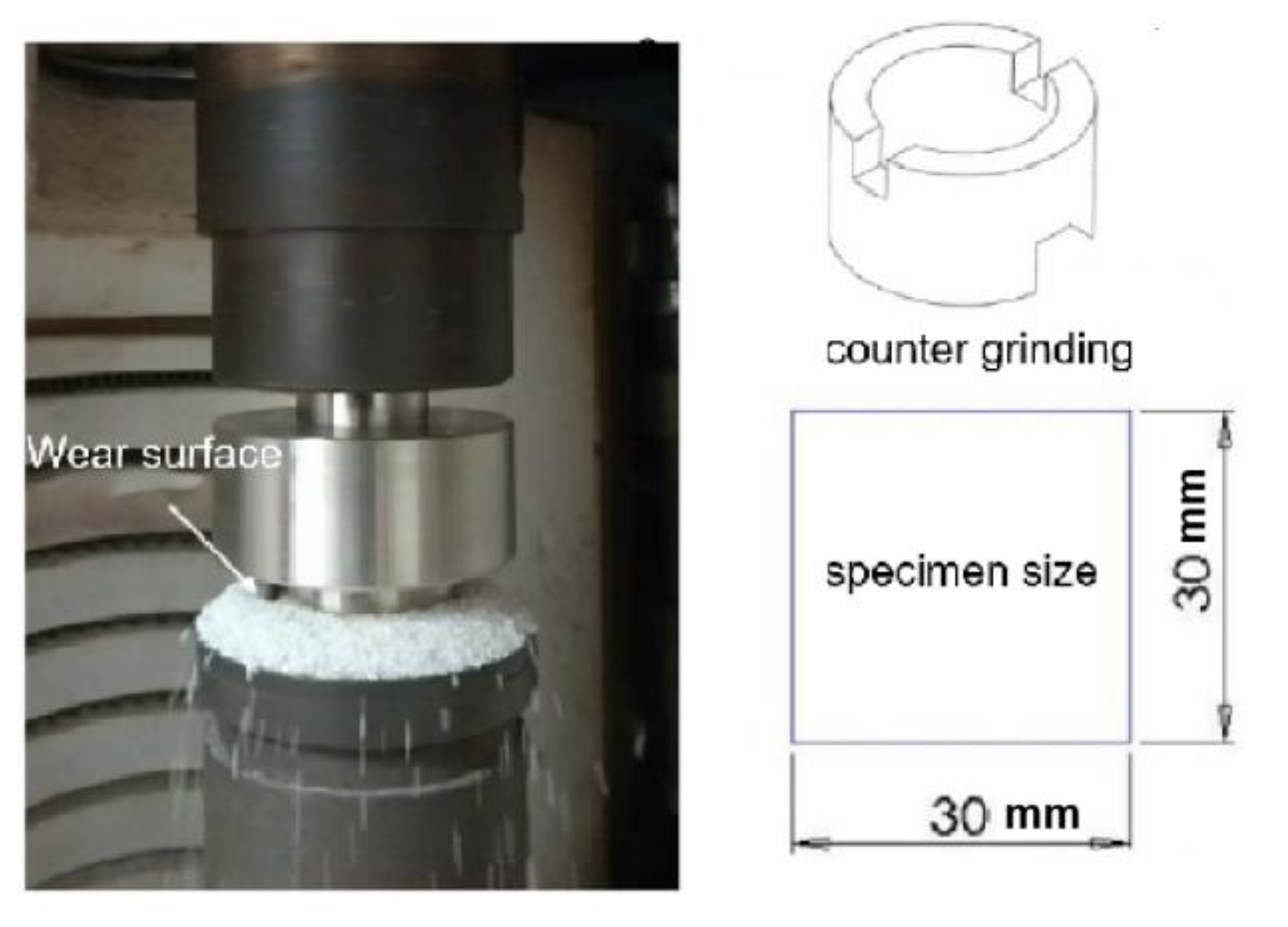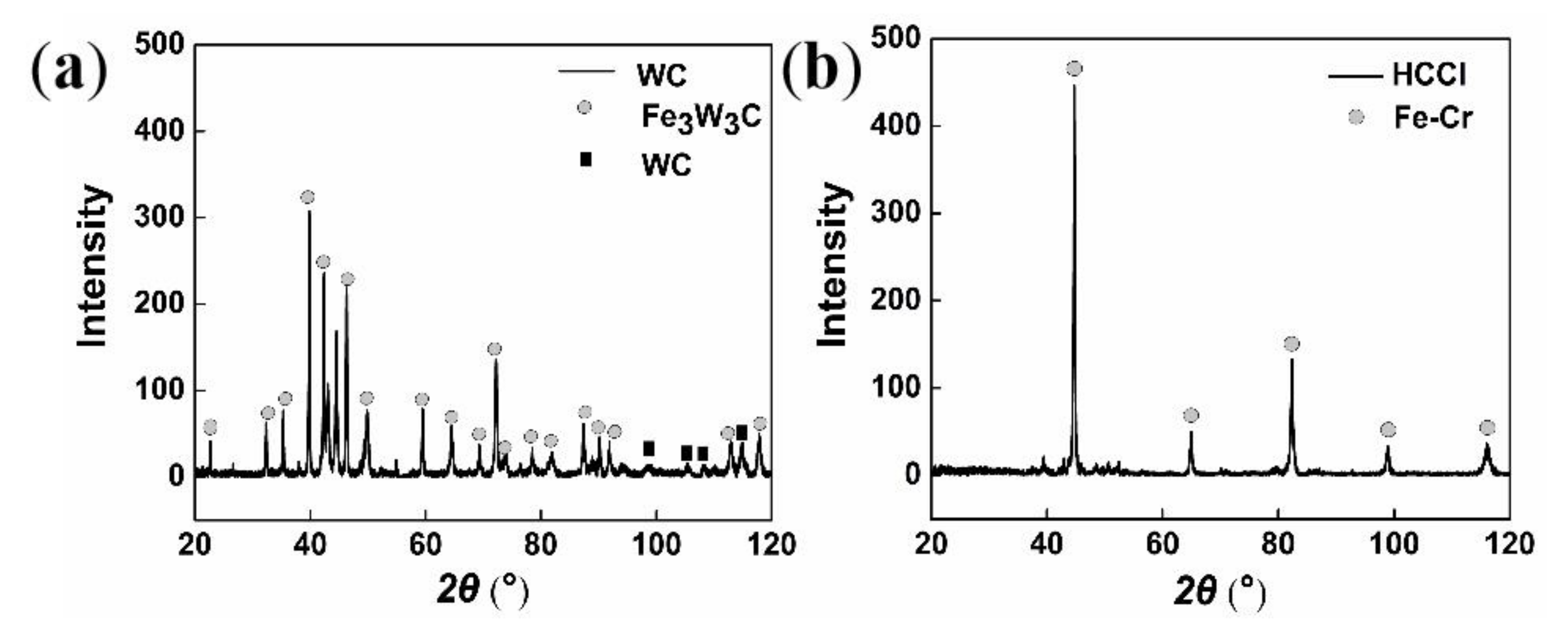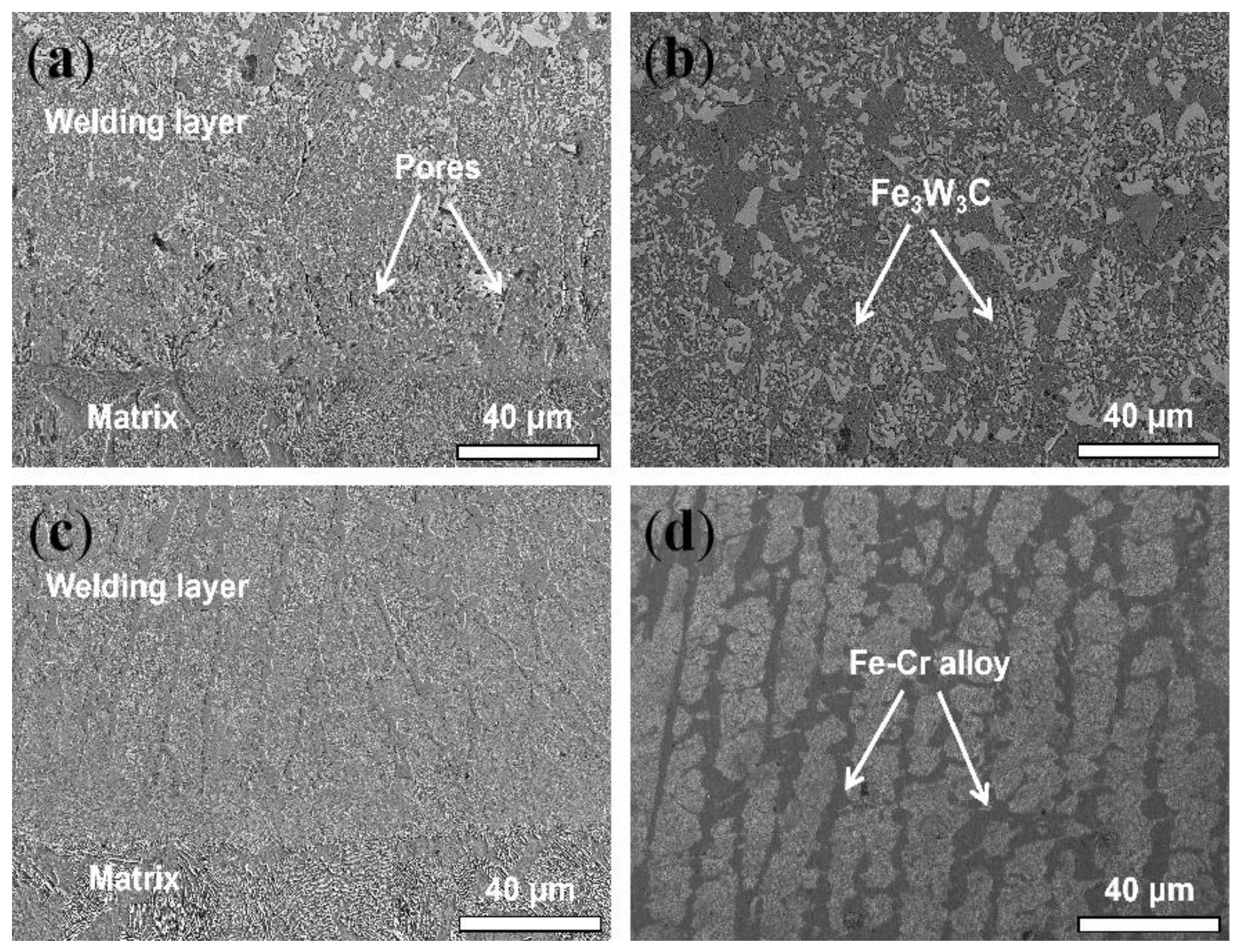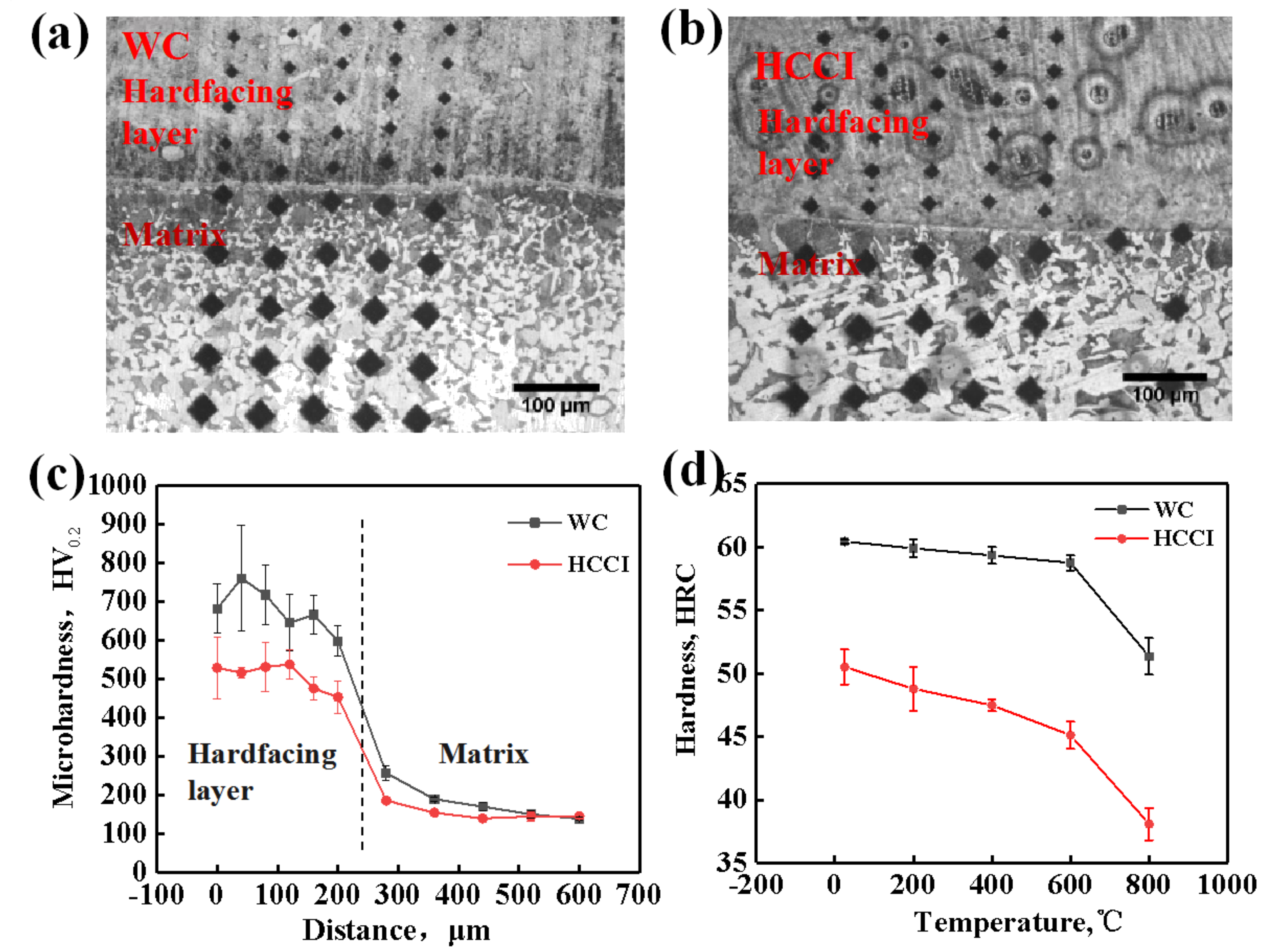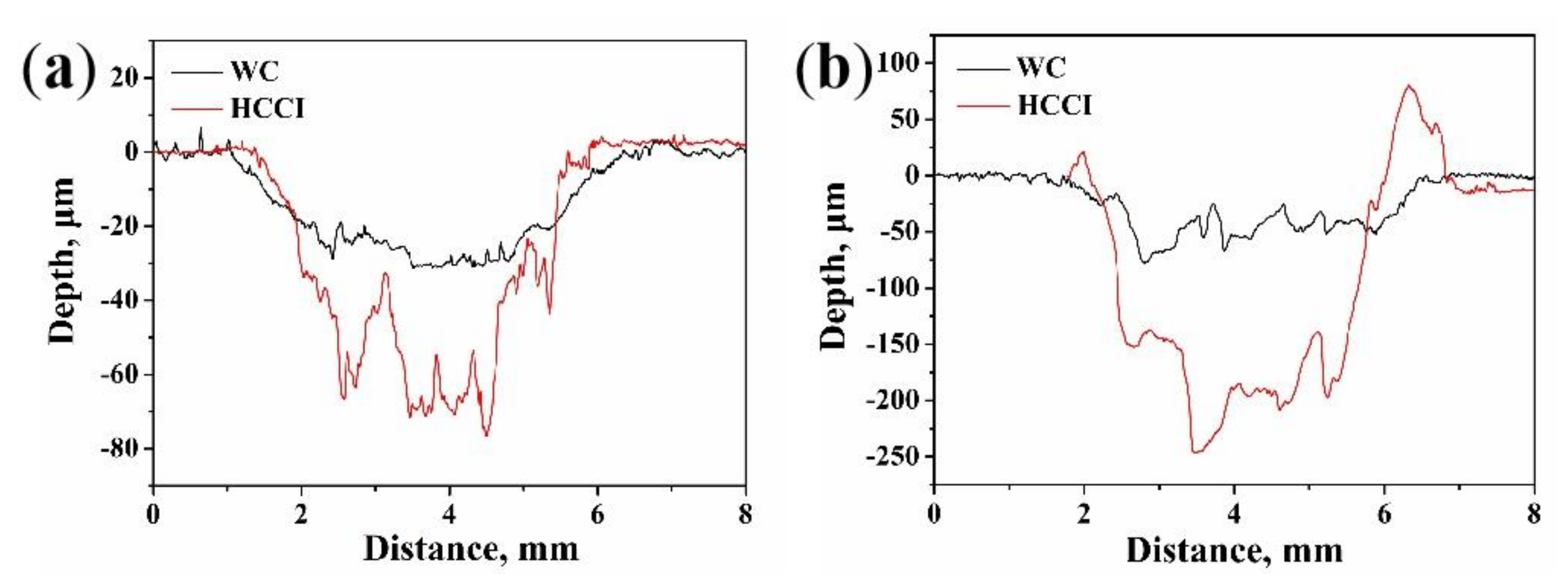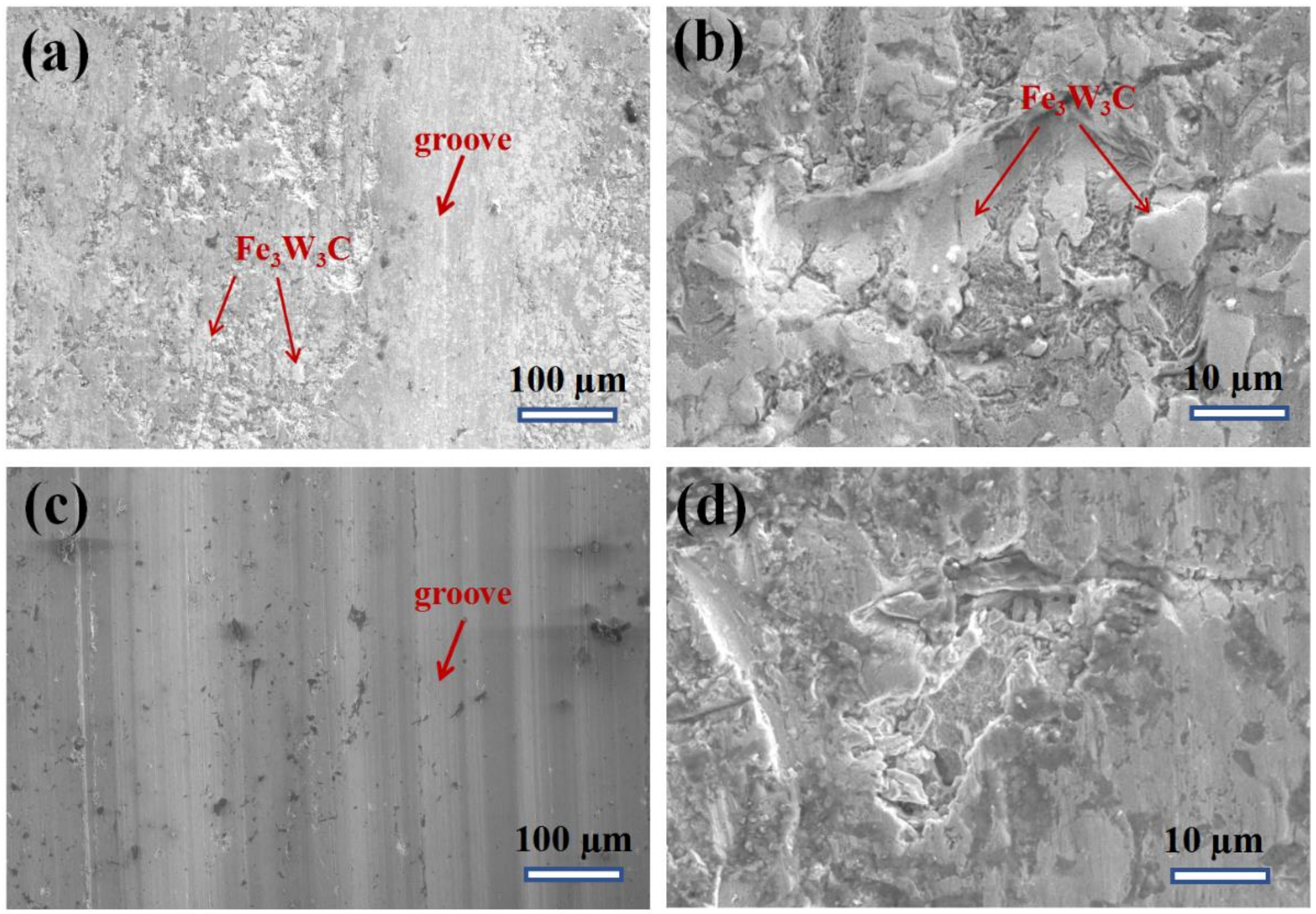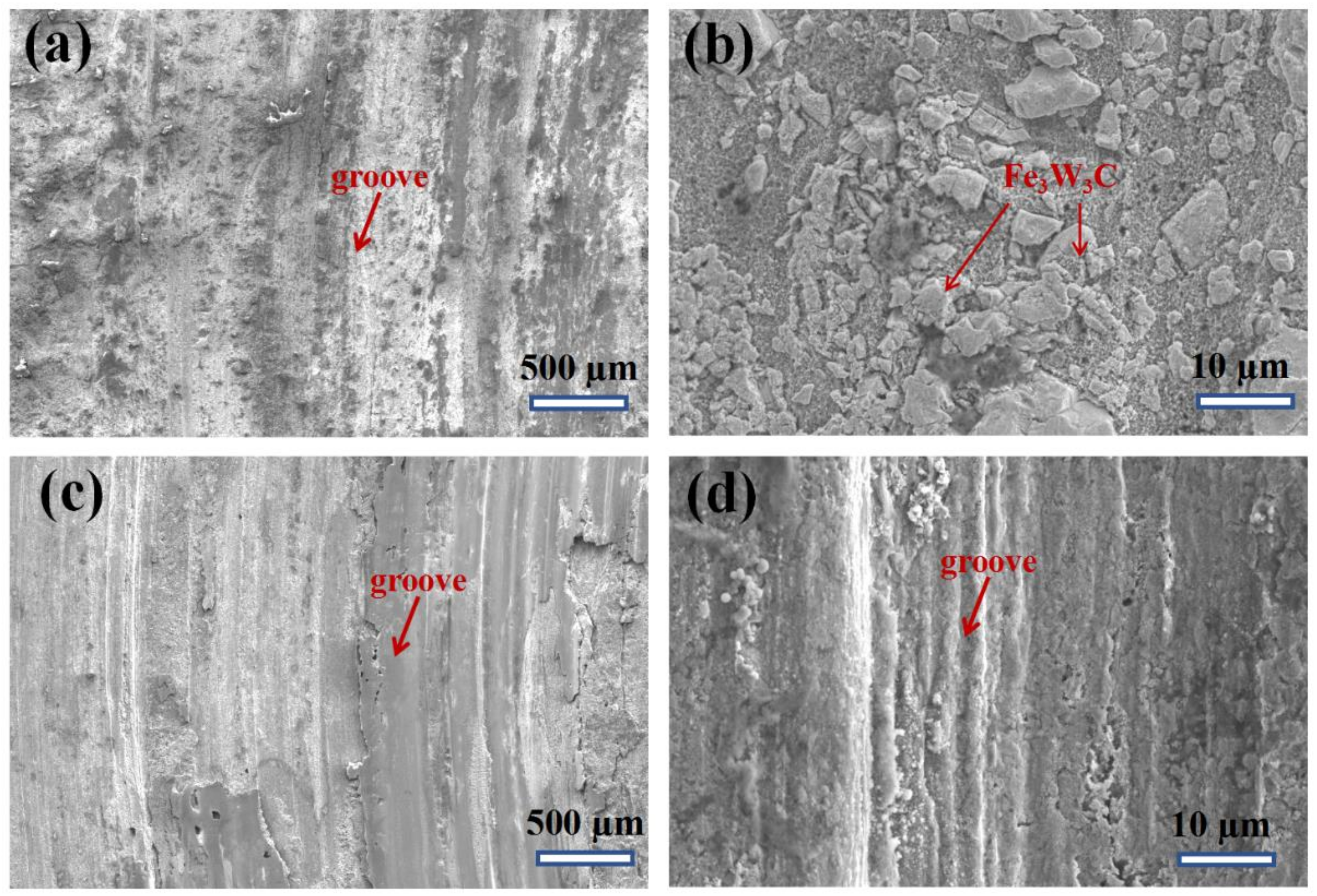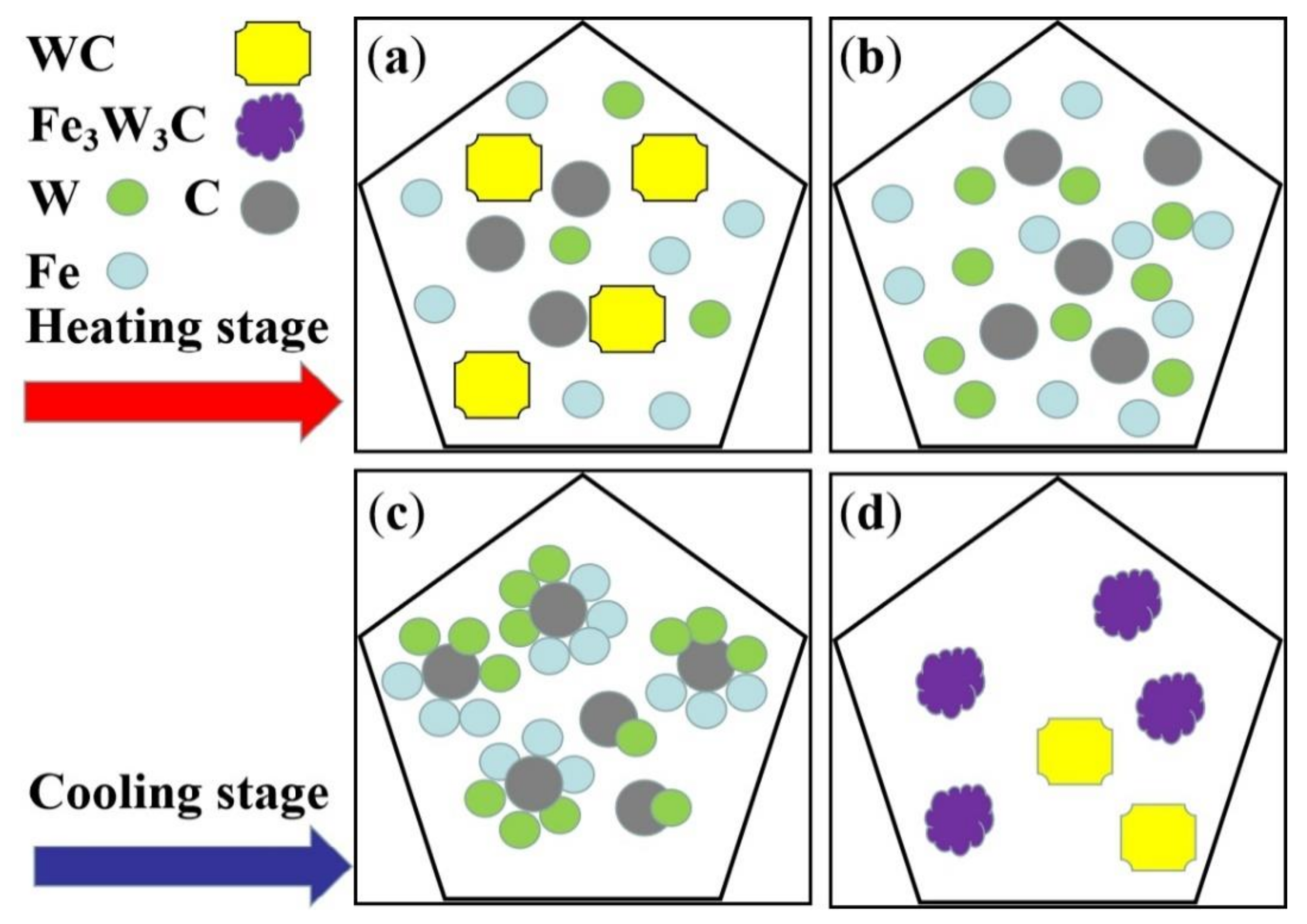1. Introduction
Q235 low carbon steel has been widely used as structural material due to its good plasticity and welding performance. However, low hardness and poor wear resistance, especially at elevated temperatures, limit its application at severe wear conditions. Thus, surface hardening and coating techniques have been applied to improve the wear resistance of Q235 steel [
1,
2,
3].
Among all the existing techniques, hardfacing is one of the most attractive methods due to its exceptionally low cost, high hardness of welded layer, excellent interfacial bonding force, and low residual stress [
1,
3,
4,
5]. It should be noted that hardfacing can not only repair damaged workpieces but also form a cladding metal layer with excellent properties, such as wear resistance, heat resistance, or corrosion resistance on the surface of the workpiece. The properties of the surfacing layer are controlled by the compositions of the surfacing electrode. For instance, a high-manganese steel surfacing electrode was used to obtain a fully austenitic layer with high work-hardening rate, high toughness, and good wear resistance [
6]. Furthermore, ceramic particles, such as WC, TiC, and SiC, were introduced to the surfacing electrodes [
2,
4,
7,
8,
9]. The ceramic reinforced welded layer can be applied to the strongly worn parts, such as concrete mixer blades, high-speed sand mixing boxes, and bulldozers. It is noted that WC is a favorable reinforcement in steels due to its good wettability with the matrix [
2,
10,
11]. Furthermore, it is expected that the WC-containing surfacing layer can also be applied to workpieces that service at high temperatures. However, compared to the room-temperature properties [
1], the high-temperature properties of the WC welded layer have received less attention in the literature.
In this study, the WC welded layer and high chromium cast iron (HCCI) welded layer were fabricated on a low carbon steel matrix (Q235) by a continuous multiple-layer surfacing technique. The microstructure of the welded layers was investigated. The hardness of the welded layers was measured at room and high temperatures. Furthermore, a three-body abrasive wear resistance test setup was designed to evaluate the wear properties of the welded layer at high temperatures and room temperature.
3. Results
Figure 2 shows the XRD patterns of the WC and HCCI welded layers. It shows that the WC welded layer contains three phases: Fe
3W
3C, BCC iron, and WC. Contrary to conventional views, the Fe
3W
3C is the main phase of the WC welded layer, as shown in
Figure 2a. The intensity of the diffraction peaks of WC phase is very weak compared to the other two phases. This demonstrates that the WC particle is not stable during the welding process in the present Fe–WC system. On the other hand, the Fe–Cr phase is the dominant phase of the HCCI welded layer, as shown in
Figure 2b. The fine peaks in
Figure 2b belong to the Cr
7C
3 and Cr
23C
6 phases in the HCCI welded layer.
Figure 3 displays the cross-section microstructure of the WC and HCCI welded layers. Both welded layers show good bonding with the matrix since no interfacial cracks were observed in the SEM. Some pores can be found in the interface of the WC welded layer, as shown in
Figure 3a, but there is no pore in the interior of the welded layer, as shown in
Figure 3b. Higher magnification images show that the microstructure of the WC welded layer contains two categories of particles, and these particles are W-rich, as shown in
Figure 3b. Combined with the XRD results, we can conclude that the particles in the WC welded layer are mainly the Fe
3W
3C phase. For the HCCI welded layer, the microstructure consists of two interconnected phases, as shown in
Figure 3d.
Furthermore, we conducted the Vickers hardness tests to evaluate the hardness changes from the welded layer to the matrix of the WC and HCCI layers.
Figure 4a,b show the indentations on the hardfacing layer and matrix. Five tests were conducted for each data point.
Figure 4c shows the hardness results. It shows that the hardness of the hardfacing layer is much higher than that of the matrix. Furthermore, the hardness of the WC welded layer is higher than that of the HCCI hardfacing layer in the same distances from the welding interface.
In order to evaluate the high-temperature properties of the hardfacing layers,
Figure 4b shows the results of the temperature-dependent hardness tests. It is noted that the hardness of the WC layers is higher than that of the HCCI welded layer at all the temperatures. Meanwhile, the hardness of the WC welded layer just decreases slightly with temperature at temperatures lower than 600 °C, as shown in
Figure 4b. The HRC of the WC welded layer at 800 °C is as high as 52 HRC. For comparison, the hardness of the HCCI welded layer decreases quickly with temperature and the hardness becomes as low as 37 HRC at the temperature of 800 °C. This shows that the WC welded layer has a higher hardness than the HCCI welded layer, especially at high temperatures.
Table 2 shows the abrasive wear properties of the WC and HCCI welded layers at room temperature. Weight loss was used to evaluate wear resistance. It shows that the weight loss of the HCCI layer is about two times that of the WC welded layer. In other words, the wear resistance of the present WC hardfacing layer is twice that of the HCCI hardfacing layer, which is consistent with the hardness test results as shown in
Figure 4c. The abrasive properties can be investigated by weight loss at room temperature. However, obvious weight gain can be caused by oxidation at high temperatures. Therefore, we conduct profile analysis on the wear trace on the specimens after an abrasive wear test, as shown in
Figure 5. The volume loss of the trace was calculated. Four profiles were used to obtain statistically reliable data.
Table 3 shows the volume loss results at room and high temperatures of two welded layers. Wear resistance was reflected by the reciprocal of volume loss. This shows that the wear resistance of the WC welded layer is about twice that of the HCCI layer at room temperature, which is consistent with the results provided in
Table 2. However, at 800 °C, the wear resistance of the WC welded layer is three times that of the HCCI welded layer. This demonstrates that the present WC welded layer has excellent wear resistance at high temperatures.
Figure 6 shows the worn surface of the WC welded layer
Figure 6a,b and the HCCI welded layer
Figure 6c,d. And the cross-section profiles of both the welded layers at room temperature and high temperature. For the WC welded layer at room temperature conditions, Fe
3W
3C particles can be observed on the worn surface, as shown in
Figure 6a. A higher magnification SEM image (
Figure 6b) shows that there are no interior and interfacial cracks in the Fe
3W
3C particles after wear tests. The extrusion of the Fe
3W
3C particles shows that the presence of these particles can effectively resist wear and hence, improve the wear resistance. For comparison, the worn surface of HCCI at room temperature is very flat and consists of many large grooves.
Figure 7 shows the worn surface after abrasive wear tests at 800 °C. Compared with
Figure 6, it shows that oxidation takes place obviously at high temperatures, since the worn surface becomes porous, as shown in
Figure 7b,d. The oxidation process will accelerate weight loss during the abrasive wear process. Furthermore, some fine grooves were found in the HCCI welded layer, as shown in
Figure 7d. This shows that microcutting may be the dominant failure mechanism for the HCCI welded layer at high temperatures. For comparison, obvious particle extrusion was observed on the worn surface of the WC welded layer after abrasive tests at 800 °C, as shown in
Figure 7b. This shows that the Fe
3W
3C particles can also resist wear at high temperatures.
4. Discussion
The microstructure, hardness, and abrasive wear properties of the WC and HCCI welded layers were investigated in this work. Contrary to conventional views, we find that the WC welded layer contains a minor WC phase. The Fe
3W
3C phase is the dominant strengthening particle in the WC welded layer. This shows that the WC particles will decompose during the welding process.
Figure 8 is a schematic diagram that shows the formation processes of the Fe
3W
3C phase. During the welding process, while the temperature reaches a temperature of about 2870 °C, the WC particle begins to melt and the C and W atoms dissolve from the compounds (
Figure 8a). As the temperature rises continuously, the molten pool emerges at the highest temperature and long-range diffusion of C, W, and Fe atoms occurs (
Figure 8b). During the cooling stage, the Fe
3W
3C phase is formed firstly due to its low binding energy, as shown in
Figure 8c. As the reaction continues, when the localized Fe is consumed by the formations of the Fe
3W
3C phase, some WC particles are formed, as shown in
Figure 8d.
Based on the above results, the excellent wear resistance of the WC welded layer is caused by the formation of Fe
3W
3C particles. As shown in
Figure 3a, it was found that different shapes of Fe
3W
3C particles are randomly distributed on the surface and the maximum size of Fe
3W
3C particles is less than 15 μm. On the contrary, although the hard phase can be observed on the surface of the HCCI welded layer, the size of the primary Fe–Cr phase exceeds 50 μm and it is not suitable for wear conditions. Therefore, the fine Fe
3W
3C particles contribute to the excellent mechanical properties of the WC welded layer. It has been reported that fine and sphere WC particles have a better strengthening effect than that of the irregular WC particles in the Co matrix welded layer, since the presence of a round particle can reduce the residual stress formed during solidification [
2]. However, in the present Fe–WC welding system, the introduction of spherical WC particles is not necessary because most of the WC phase will transform to the Fe
3W
3C phase.
The present experimental results show that the wear resistance of the WC welded layer is better than that of the HCCI welded layer. The difference of wear properties and worn surface of these two welded layers can be due to the different hardness (
Figure 4c,d). For the high-temperature abrasive wear tests, oxidation occurs simultaneously; the oxide scale is brittle and can be readily removed during the wear process. Therefore, corrosion and microcutting are the dominant mechanisms for the mass loss of the HCCI welded layer at high temperatures. However, for the WC welded layer, the Fe
3W
3C particles emerge on the surface and no fracture and pull-out are found. It suggests that Fe
3W
3C may have high oxidation resistance, thus, contributing to the improved wear resistance at high temperatures.
